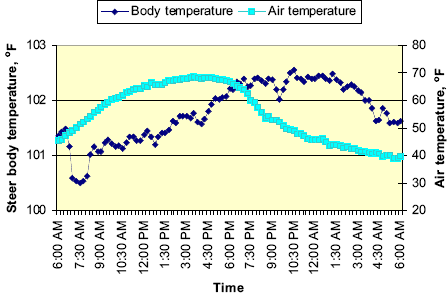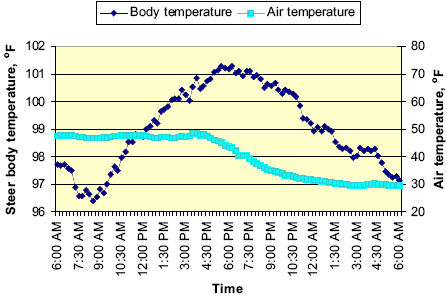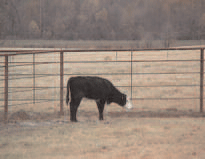



Identifying Sick or Injured Cattle
Proper and timely identification of sick or injured cattle helps minimise unnecessary treatment expense and preventable production losses, write Dr. Jane A. Parish, Associate and Dr. Justin D. Rhinehart, Mississippi State University Extension Service.Accurately pulling cattle needing examination or treatment is difficult but essential in order to treat sick or injured cattle without unnecessarily spending money on or adding stress to healthy cattle. Sick calves can be identified in several ways. The most popular is rectal temperature and visual indications.
Identifying Sick Cattle
Body Temperature
When properly used, body temperature can be a good indicator of illness. A greater incidence of calf illness can be identified using body temperatures rather than visual observation alone. One common rule of thumb in beef cattle operations is to designate cattle with rectal temperatures of 104 °Fahrenheit or greater as sick. In addition, consider visibly ill cattle sick regardless of body temperature.
Body temperature rises in cattle infected with a disease-causing organism as the immune system begins to fight the infection. Some untreated cattle overcome infection and recover, while others suffer elevated body temperatures and show other signs of illness. In cattle that begin to succumb to disease, clinical signs worsen and body temperature eventually falls well below normal, creating a dangerous health situation. Early detection of elevated body temperatures and rapid recognition of clinical signs of illness are important for effective treatment of sick cattle.
To use body temperature properly as a measure of illness, it is necessary to know what is “normal.”
Unfortunately, normal temperatures for cattle rise during the day. Cattle producers must consider this when deciding when to use body temperature as an indicator for pulling sick cattle.
Cattle do not maintain body temperature in a tight range as humans do. Unlike humans, cattle expel body heat primarily through respiration rather than sweating. In fact, body temperature in cattle follows a daily pattern where there is a period of increasing heat load and rising body temperature followed by a period of heat dissipation and falling body temperature.
Cattle body temperatures rise during the day rather than the animals spending energy to get rid of the heat. Minimum body temperature usually occurs early in the morning, then steadily increases during the day. The heat load built up during the day is dissipated at night such that body temperature falls gradually during the night, reaching a daily low early in the morning. This process occurs even on cold days.
Cattle body temperatures tend to increase during daylight hours. Heat load is then dissipated at night. This is the case in both warm and cold weather conditions. It also occurs in controlled environments with a standard temperature, so factors other than the outside temperature have a significant influence on cattle body temperature. Feeding, activity level, solar radiation, and humidity also influence cattle body temperatures. Acute elevations in body temperature occur directly after feeding or exercise.
Fevers are identified more accurately when body temperatures are at their daily lows. For proper identification of sick cattle, make sure that body temperatures are not taken too late in the day when false positives for illness might occur.
While working cattle in the late evening may seem like a good idea, cattle generally need several hours past sundown to dissipate heat and cool down from an extremely hot day. It is critical to take temperatures before mid-morning. Producers measuring cattle temperature in the afternoon, even on a cold day, and letting cattle stand around for three or four hours before processing may identify cattle for treatment that are actually healthy.
Be careful to minimize exercise and stress just before measuring temperatures. Cattle should never stand for more than 20 minutes in alleyways or chute of handling facilities before temperatures are taken. Once in the chute, measure body temperatures immediately. It may be necessary to divide cattle into small groups that can be worked in a reasonable amount of time instead of trying to work the entire group at once.
Steer body temperature measured every 15 minutes during a warm day

Source: R. H. Watson, The University of Georgia, Georgia Automated Environmental Monitoring Network, www.Georgiaweather.net
Steer body temperature measured every 15 minutes during a cold day

Source: R. H. Watson, The University of Georgia; Georgia Automated Environmental Monitoring Network, www.Georgiaweather.net
Visual Signs of Cattle Illness
When using visual appraisal, one of the most important signals of illness is appetite suppression. Feed consumption of cattle exposed to respiratory disease begins to decrease about 48 hours before increased body temperature is observed.
The most effective time to observe the feeding behavior of cattle is when they are fed each day. Unfortunately, it is difficult to monitor daily feeding patterns of grazing cattle or calves on self feeders. In this case, observe signs of gut fill. Cattle that have not been eating and drinking properly appear gaunt, and their abdomens often bounce when they walk. Rapid weight or body condition loss also indicates illness.
Other later occurring signs of illness include labored breathing, deep coughing, eye and nasal discharge, bloody diarrhea, or depression. Depression is noted as drooping head and ears, excessively slow movement, lagging behind the rest of the herd, and reluctance to get up when approached.
These symptoms occur after sick cattle have gone off feed and their rectal temperature has risen. Therefore, it is extremely important to thoroughly observe cattle daily to catch illness early and begin an effective treatment protocol.
Vaccination can produce signs of illness in some situations. Discuss expected effects of specific vaccines on cattle before administration to distinguish between an animal that is ill or one that is suffering a temporary side effect of vaccination.
Examining cattle manure can also help identify sick animals. Loose manure with large feed particles, mucus, or blood can indicate illness or injury. While it may be difficult to identify a specific animal in grazing situations, producers can at least be alerted to watch the herd closer. Cattle often defecate during handling, so plan to observe manure during this time.

Identifying Injured Cattle
Injuries in cattle may be minor or severe. Some injuries are relatively easy to detect upon observation, such as injuries that result in lameness or inability to stand up or walk (a non-ambulatory or “downer” animal). These types of injuries can prevent marketing an animal or result in market discounts. Other injuries are more subtle, including bruising and internal organ injuries such as hardware disease. Suspect these types of injuries when cattle display behavioral changes such as appetite changes or reluctance to move.
Examine the animal’s environment for potential hazards or conditions that may have caused an injury. Horns contribute to bruising in animals housed together. Injuries to breeding animals often occur during the breeding season as a result of mounting behavior. Inadequate feed trough space increases competition for feed and chance of injury. Sharp objects such as wire and nails in pastures or handling areas also contribute to cattle injuries.
Inspect cattle closely during feeding and animal handling to identify injuries that are not easily seen in pasture settings. Foot injuries, eye injuries, mouth injuries, minor lacerations (cuts), hematomas (blood vessel rupture and blood pooling under the hide), penis injuries, and biting insect damage are examples of injuries that sometimes require close inspection to identify. By identifying injuries during animal handling, animals can be treated while restrained.
Conclusions
Identify and manage sick or injured cattle promptly. When cattle go “down,” it is often because their initial problems were ignored. A treatment plan should be in place once sick or injured cattle are identified. Consult with a veterinarian to develop this plan. Then follow the plan closely.
Seek out veterinary advice for situations that may require treatments not outlined in standard herd health plans. For more information on identifying sick or injured cattle, contact an office of the Mississippi State University Extension Service or a veterinarian.
July 2009


